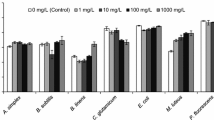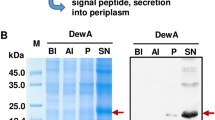Abstract
One of the two putative groups of antiadhesins was identified in Pseudomonas fluorescensby the method of gas chromatography–mass spectrometry. A mixture of high-molecular unbranched hydrocarbons (HC) with a chain length from 21 to 33 carbon atoms reduced cell adhesion to a glass surface. These HC accumulated in the culture liquid to a total concentration of 10–15 μg/l; the concentrations of individual HC ranged from 0.1 to 3.0 μg/l. After the addition of individual HC to the bacterial culture, the number of cells attached to the glass surface decreased. This decrease in cell adhesion was due to the enhanced aggregation of the bacterial cells, which promoted mechanical (hydrodynamic) cell detachment from the surface.
Similar content being viewed by others
References
Fletcher, M., Effect of Solid Surfaces on the Activity of Attached Bacteria, Bacterial Adhesion (Mechanisms and Significance), Savage, D.C. and Fletcher, M., Eds., New York: Plenum, 1985, pp. 339–362.
Fletcher, M., Bacterial Attachments in Aquatic Environments: A Diversity of Surfaces and Adhesion Strategies, Bacterial Adhesion (Molecular and Ecological Diversity), New York: Wiley-Liss, 1996, pp. 1–24.
Marshall, K.C., Mechanisms of Bacterial Adhesion at Solid-Water Interfaces, Bacterial Adhesion (Mechanisms and Significance), Savage, D.C. and Fletcher, M., Eds., New York: Plenum, 1985, pp. 133–162.
Kogure, K., Ikemoto, E., and Morisaki, H., Attachment of Vibrio alginolyticus to Glass Surfaces Is Dependent on Swimming Speed, J. Bacteriol., 1998, vol. 180, no. 4, pp. 932–937.
Boyd, A. and Chakrabarty, A.M., Role of Alginate Lyase in Cell Detachment of Pseudomonas aeruginosa, Appl. Environ. Microbiol., 1994, vol. 60, pp. 2355–2359.
Nikolaev, Yu.A. and Prosser, J.I., Extracellular Factors Affecting the Adhesion of Pseudomonas fluorescens Cells to Glass Surfaces, Mikrobiologiya, 2000, vol. 69, no. 2, pp. 231–236.
Nikolaev, Yu.A. and Prosser, J.I., Some Properties of the Pseudomonas fluorescens Adhesin and Antiadhesin, Mikrobiologiya, 2000, vol. 69, no. 2, pp. 237–242.
Nikolaev, Yu.A. and Mil'ko, E.S., Adhesive and Growth Properties of the R and S Variants of Pseudomonas fluorescens, Mikrobiologiya, 2000, vol. 69, no. 2, pp. 293–294.
Spravochnik biokhimika (Biochemical Handbook), Kiev: Naukova Dumka, 1971.
Mil'ko, E.S. and Egorov, N.S., Geterogennost' populyatsii bakterii i protsess dissotsiatsii (Heterogeneity of Bacterial Populations and the Dissociation Process), Moscow: Mosk. Gos. Univ., 1991.
Dedyukhina, E.G., Zhelifonova, V.P., and Eroshin, V.K., Microbial Hydrocarbons, Usp. Mikrobiol., 1980, vol. 15, pp. 84–98.
Bagaeva, T.V. and Zolotukhina, L.M., Synthesis of Hydrocarbons by Sulfate-reducing Bacteria during Chemolithoheterotrophic Growth, Mikrobiologiya, 1994, vol. 63, no. 6, pp. 993–995.
Soboleva, E.V. and Guseva, A.N., Khimiya goryuchikh iskopaemykh (Chemistry of Combustible Fossils), Moscow: Mosk. Gos. Univ., 1998.
Kates, M., Techniques of Lipidology. Isolation, Analysis and Identification of Lipids, Amsterdam: Elsevier, 1972. Translated under the title Tekhnika lipidologii, Moscow, Mir, 1975.
Author information
Authors and Affiliations
Rights and permissions
About this article
Cite this article
Nikolaev, Y.A., Panikov, N.S., Lukin, S.M. et al. Saturated C21–C33Hydrocarbons Are Involved in the Self-Regulation of Pseudomonas fluorescensAdhesion to a Glass Surface. Microbiology 70, 138–144 (2001). https://doi.org/10.1023/A:1010481127377
Issue Date:
DOI: https://doi.org/10.1023/A:1010481127377




